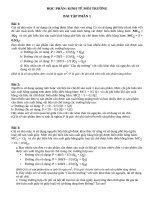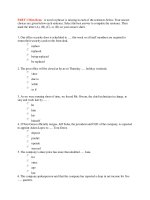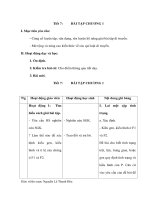BÀI TEST READING (1) pot
Bạn đang xem bản rút gọn của tài liệu. Xem và tải ngay bản đầy đủ của tài liệu tại đây (29.65 KB, 19 trang )
BÀI TEST READING (1)
TEST 1 – READING PASSAGE 1:
Questions 1 - 5
Reading Passage 1 below has 5 paragraphs (A-E). Which
paragraph focuses on the information below? Write the
appropriate letters (A-E) in Boxes 1-5 on your answer sheet.
1. The way parameters in the mind help people to be
creative.
2. The need to learn rules in order to break them.
3. How habits restrict us and limit creativity.
4. How to train the mind to be creative.
5. How the mind is trapped by the desire for order.
THE CREATION MYTH
A. It is a myth that creative people are born with their
talents: gifts from God or nature. Creative genius is, in
fact, latent within many of us, without our realising. But
how far do we need to travel to find the path to
creativity? For many people, long way. In our everyday
lives, we have to perform many acts out of habit to
survive, like opening the door, shaving, getting dressed,
walking to work, and so on. If this were not the case, we
would, in all probability, become mentally unhinged. So
strongly ingrained are our habits, though this varies
from person to person, that, sometimes, when a
conscious effort is made to be creative, automatic
response takes over. We may try, for example, to walk to
work following a different route, but end up on our usual
path. By then it is too late to go back and change our
minds. Another day, perhaps. The same applies to all
other areas of our lives. When we are solving problems,
for example, we may seek different answers, but, often
as not, find ourselves walking along the same well-
trodden paths.
B. So, for many people, their actions and behaviours are
set in immovable blocks, their minds clogged with the
cholesterol of habitual actions, preventing them from
operating freely, and thereby stifling creation.
Unfortunately, mankind’s very struggle for survival has
become a tyranny – the obsessive desire to give order
to the world is a case in point. Witness people’s attitude
to time, social customs and the panoply of rules and
regulations by which the human mind is now
circumscribed.
C. The groundwork for keeping creative ability in check
begins at school. School, later university and then work
teach us to regulate our lives, imposing a continuous
process of restriction, which is increasing exponentially
with the advancement of technology. Is it surprising
then that creative ability appears to be so rare? It is
trapped in the prison that we have erected. Yet, even
here in this hostile environment, the foundations for
creativity are being laid; because setting off on the
creative path is also partly about using rules and
regulations. Such limitations are needed so that once
they are learnt, they can be broken.
D. The truly creative mind is often seen as totally free and
unfettered. But a better image is of a mind, which can be
free when it wants, and one that recognises that rules
and regulations are parameters, or barriers, to be raised
and dropped again at will. An example of how the
human kind can be trained to be creative might help
here. People’s mind are just like tense muscles, that
need to be freed up and the potential unlocked. One
strategy is to erect artifitial barriers or hurdles in solving
a problem. In this way, they are obliged to explore
unfamiliar territory, which may led to some startling
discoveries. Unfortunately, the difficulty in this exercise,
and with creation itself, is convincing people that
creation is possible, shrouded as it is so much myth and
legend. There is also an element of fear involved,
however subliminal, as deviating from the safety of
one’s own thought patterns is very much akin to
madness. But, open Pandora’s box, and a whole new
world unfolds before your eyes.
E. Lifting barriers into place also plays a major part in
helping the mind to control ideas rather than letting
them collide at random. Parameterrs act as containers
for ideas, and thus help the mind to fix on them. When
the mind is thinking laterally, and two ideas from
different areas of the brain come or are brought
together, they form a new idea, just like atoms floating
around and then forming a molecule. Once the idea has
been formed, it needs to be contained or it will fly away,
so fleeting is its passage. The mind needs to hold it in
place for a time so that it can recognise it or call on it
again. And then the parameters can act as channels
along which the ideas can flow, developing and
expanding. When the mind has brought the idea to
fruition by thinking it through to its final conclusion, the
parameters can be brought down and the idea allowed
to float off and come in contact with other ideas.
Questions 6 – 10
6. According to the writer, creative people
A. are usually born with their talents
B. are born with their talents
C. are not born with their talents
D. are geniuses
7. According to the writer, creativity is
A. a gift from God or nature
B. an automatic response
C. difficult for many people to achieve
D. a well-trodden path
8. According to the writer :
A. the human race’s fight to live is becoming a tyranny
B. the human brain is blocked with cholesterol
C. the human race is now cicumbribed by talents
D. the human race’s fight to survive stifles creative ability
9. Advancing technology
A. holds creativity in check
B. improves creativity
C. enhances creativity
D. is a TYRANNY
10.According to the author, creativity…
A. is common
B. is increasingly common
C. is becoming rarer and rarer
D. is a rare commodity
Questions 11 – 15
Do the statements below agree with the information in
Reading Passage 1? In boxes 11 – 15, write:
Yes If the statement agrees with the information in the
passage
No If the statement contradicts the information in the
passage
Not given If there is no information about the statement
in the passage
11.Rules and regulations are examples of parameters.
12.The truly creative mind is associated with the need for
free speech and a totally free society.
13.One problem with creativity is that people think it is
impossible.
14.The act of creation is linked to madness.
15.Parameters help the mind by holding the ideas and
helping them to develop.
KEY TO TEST 1 – READING PASSAGE 1:
Questions 1 – 5:
This type of question is a variation of paragraph headings.
There are no distracters in this section, which makes it much
easier.
1. Answer: E. The paragraph is about the fact that parameters
help our minds to be creative.
2. Answer: C. The answer lies in the key phrases: keeping
creative ability in check (in the first sentence) and These
limitations are needed so that once they are learnt, they can be
broken (the last sentence of the paragraph). The focus sentence
is a combination of these two ideas. Note how the word yet
devides the paragraph. It indicates the focus of the paragraph
against the background in the first part. It also marks the division
of information in the whole passage.
3. Answer: A. The writer wrote the paragraph to show that habits
limit our creativity and the habits we need to survive play a role in
this limitation.
4. Answer: D. The theme of the paragraph is how creativity works.
5. Answer: B. The paragraph deals with how parameters help the
mind to be creative.
Questions 6 - 10
6. Answer: C. The answer is in the first line of the passage: It is a
myth that creative people are born with their talents. Here, it is a
myth = are not.
7. Answer: C. The answer is in paragraph A. The actual words
are not in the paragraph, but the meaning is clear. A is not
correct, because this is a myth. B is not correct, because the
passage states that when we try to be creative, our automatic
response takes over. D is not correct, because the well-trodden
paths prevent creativity. Compare number 13 below.
8. Answer: D. The answer is in paragraph B: Unfortunately,
mankind’s very struggle for survival has become a tyranny. The
answer paraphrases this statement. A is not correct, because the
passage says the struggle has become i.e. is a tyranny, not that it
is becoming so. B is not correct, because cholesterol is not
mentioned in relationship to the brain, but the mind. C is incorrect,
because it is the mind which is circumscribed.
9. Answer: A. The answer is in paragraph C: a continuous
process of restriction, which is increasing exponentially with the
advancement of techonology. The statement is a paraphrase of
this section. Note B and C are basically the same; it is, therefore,
not possible to have either of these two alternatives as your
answer. Watch out for this feature in multiple choice questions.
10. Answer: D. The answer is in paragraph C: Is it
surprising then that creative ability appears to be so rare? This is
question and has the same meaning as the statement given, i.e. it
is not surprising. Note C is not possible, because the passage
doesn’t indicate whether the rarity is increasing or decreasing.
Questions 11 - 15
11. Answer: Yes. The answer is at the beginning of
paragraph D: and one that recognises that rules and regulations
are parameters
12. Answer: Not Given. There is no reference to this
statement in the passage.
13. Answer: Yes. The answer is in paragraph D: The
difficulty in this exercise and with creation itself is convincing
people that creation is possible. The answer is a paraphrase of
this part of the text. Compare number 7 above.
14. Answer: Yes. The answer is at the end of
paragraph D: leaving the safety of one’s own thought patterns is
very much akin to madness; akin to = like.
15. Answer: Yes. The answer is in the latter half of
paragraph E.









